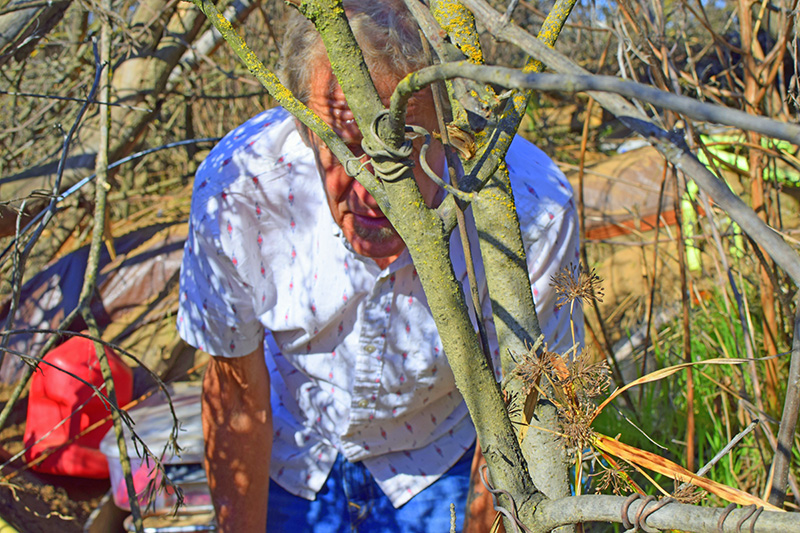Based on widespread news reports, the entire nation seems enthralled by the recent news of homeless people living in caves along the Tuolumne River near Modesto. In fact, insiders have known about the caves for years. One nearby resident said of the homeless people living in caves near his own home that, “he sees them as neighbors who are ‘going home at the end of the day.’” The statement is a strong indication that many local citizens understand the plight of people with nowhere to go, even when their presence might seem threatening.
“I just feel like if they’re not living here, where else are they gonna go?” said Nicholas McCoy to a reporter from the Modesto Bee.
Homeless people have lived in Tuolumne River Regional Park, the site where the caves were found, for at least a decade. Periodically, various portions have been shut down in attempts to discourage their presence.
City of Modesto and Stanislaus County officials insist that they have services for anyone who wants help, but local shelters are full. People wanting admission to the county’s low barrier shelter must show up in the early morning hours to get on a waiting list, then wait around to see if they’ve been admitted. Any large contingent of people wanting in — Modesto has hundreds of homeless people — would be turned away. That’s one reason for the constant official chorus about homeless people not wanting help; it provides a fig leaf for the city’s and county’s lack of resources for homeless people.

Prior to taking office, Modesto City Councilman Nick Bavaro spent months learning about the local homeless population. He consulted volunteers, police officers, homeless advocates, and talked to homeless people themselves. He also visited the various local committees dedicated to housing and homeless issues. After his research, Bavaro came to a simple conclusion:
“They don’t have anywhere to go,” he said.
Since homelessness is a major problem in his district, Bavaro began advocating a safe ground policy.
“We have the Camp to Home program,” he said, “now we need Streets to Camp.”
Two other councilmembers supported Bavaro’s proposal for safe ground for homeless people, but City Manager Joe Lopez and Mayor Sue Zwahlen were adamantly against it. They were joined in opposition by Councilmembers Rosa Escutia-Braaton, Jeremiah Williams, and David Wright.
“We can do better,” said Zwahlen, who then supported a proposal for bridge housing that would dedicate $3 million from the city’s general fund for a project that city staff estimate would cost $75,000 per unit. According to a report from the Modesto Bee, the $3 million expenditure would not include costs for service providers and site managers.

The city is pursuing grant funding for management and services, but the costs appear prohibitive, especially the $1.8 million request for ten tiny homes on a vacant lot owned by the Modesto Gospel Mission. The city has yet to approve sites and management for any of its bridge housing proposals.
Meanwhile, Chico, Sacramento, and San Diego have all implemented safe ground policies. Chico’s costs for 177 Pallet Shelter were $1.7 million, not including management and services. Sacramento has a “Safe Stay” community on Florin Road as well as safe ground at Miller Park and a Roseville Road tiny home campus, among other shelter options, including tents. Last October, San Diego opened a temporary safe sleeping site near Balboa Park that features 400 two-person tents. Officials at all three cities have recognized that homeless people have nowhere to go and there won’t be sufficient housing or services anytime in the near future.
Those facts — lack of sufficient shelter and services, especially a lack of housing — should determine homeless management policy everywhere. Unfortunately, rather than face facts, officials throughout the state continue to squander taxpayer dollars on futile sweeps that displace homeless people from one forbidden location to another.
It’s a sign of the times that the poor and needy have literally been driven underground. And while people living in caves may seem barbaric, even more disturbing is the policy that has pushed them there. Cave dwelling is a response to dire need; a policy that denies people in distress a place to lay their heads on safe ground isn’t just barbaric, it’s depraved.

$1.8M request for 10 tiny homes on a vacant lot? Owned by whom? It is a City Manager, a Mayor, some City Council members, and a bunch of NIMBY’s that are barbaric and depraved in their hearts and minds.
[…] Story continues […]